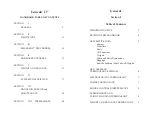Reviews:
No comments
Related manuals for C23 SUNDOWNER 180

IV
Brand: Lancair Pages: 53

Ventus-3M Performance
Brand: Schempp-Hirth Pages: 230

MOJAVE PA-31 P-350
Brand: Piper Aircraft Corporation Pages: 1148

066G103
Brand: Topmodel Pages: 27

Tiki Bamboo Bar
Brand: RAM Outdoor Decor Pages: 7

Wipline 2100
Brand: Wipaire Pages: 70

Columbia 400
Brand: Lancair Pages: 364

G150
Brand: Gulfstream Pages: 16

TU206G STATIONAIR
Brand: Cessna Pages: 188

PEAK 4
Brand: Niviuk Pages: 24

alula TREK
Brand: Dream-Flight Pages: 32

















